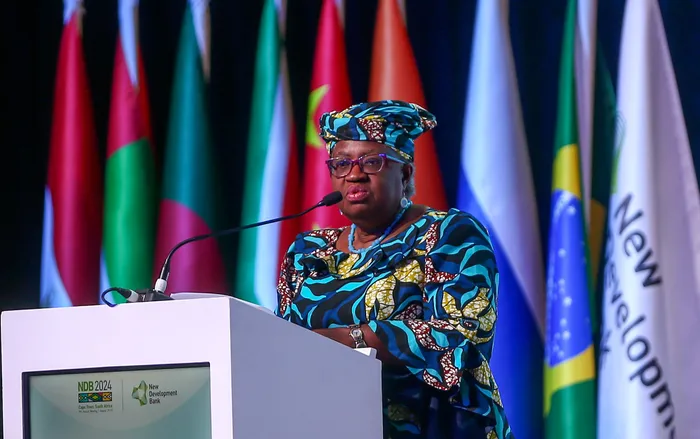Revolutionising global development financing

World Trade Organisation Director-General Ngozi Okonjo-Iweala gives a keynote speech, 'Financing for Sustainable Development in EMDCs including the role of Trade', at the Annual Meeting of the New Development Bank (NDB) in Cape Town. Established in 2015 by BRICS countries, the NDB is a multilateral development bank for mobilising resources for infrastructure and sustainable development projects in BRICS and other EMDCs. – Picture: Leon Lestrade / Independent Newspapers / August 30, 2024
By Sizo Nkala
The establishment of the BRICS New Development Bank (NDB) in 2015 was a manifestation of a significant power shift in the international system from the West to the emerging market countries like China, Brazil and India and perhaps the clearest signal of the commitment of the countries to reform the international financial system which they had argued was biased against developing countries.
Its coming into existence was historical in the sense that it demonstrated the resolve of leading Global South countries to challenge the dominance of Western countries in international development financing landscape.
Established with an initial authorised capital of $100 billion with a focus on infrastructure and sustainable development projects, the bank has availed loans worth $32.8 billion (R582bn) over 96 projects distributed between the five founding members (Brazil, Russia, India, China and South Africa).
The projects include renewable energy, water and sanitation, transport, social infrastructure and digital infrastructure. The bank now has eight members after the addition of Bangladesh, Egypt and the United Arab Emirates (UAE) in 2021.
However, its membership is poised to grow in the future in light of the recent BRICS expansion, which saw five countries – the United Arab Emirates, Egypt, Ethiopia, Saudi Arabia and Iran becoming permanent members. As the membership is open to all UN member states, as per Article 2 of the agreement establishing the NDB, other non-BRICS countries are also eligible.
At the Annual Meeting of the New Development Bank (NDB) in Cape Town giving a keynote speech Financing for Sustainable Development in EMDCs including the role of Trade. With President of NDB Dilma Rousseff, SA Min of Finance Godongwana, AIIB President Jin, and CEO Standard Bank pic.twitter.com/S79tvX6L11
— Ngozi Okonjo-Iweala (@NOIweala) August 30, 2024
Indeed, in its second general strategy (2022-2026), the bank identified membership expansion as one of its strategic goals in a bid to enhance its international profile and boost its influence in the international financial architecture.
That said, the significance of the NDB is not just that it was established by Global South countries but also in its ambitious agenda of embracing a unique model which, if successful, would revolutionise international development financing. The bank’s model comprises three distinctive elements.
First and crucial is the bank’s governance system. The five founding members of the bank have equal votes. With no one country exercising veto power, decisions are arrived at preferably through consensus or by simple majority, and the presidency of the bank is rotated among the founding members.
This is different from traditional development banks like the World Bank where the US enjoys a veto power or the Asian International Infrastructure Bank (AIIB) where China’s 26.6% shareholding grants it effective veto power over decisions it does not agree with as decisions require a 75% majority.
Moreover, in most traditional development banks, the countries holding the majority voting rights determine key appointments such as the presidency, which grants them disproportionate influence over the running of the banks.
Second, the NDB has sought to distinguish itself by prioritising operational efficiency. Departing from the traditional banks’ trademark slow pace of loan approval which can take years due to cumbersome bureaucratic and organisational requirements, the NDB committed to approving loans within six months.
Maintaining a lean organisational staff and adopting the borrower country’s social and environmental assessment systems are some of the operational innovations adopted by the bank to accelerate the approval of loans.
Established development banks like the World Bank and the African Development Bank (AfDB) have long been criticised in developing countries for delays in the approval of loan applications which is detrimental to their development.
However, to be fair, it must be acknowledged that the established MDBs have to attend to hundreds of clients that have diverse needs and development profiles which makes delays difficult to avoid.
Further, another key operational innovation of the NDB is the issuing loans in the local currencies of its members.
At the BRICS Summit in South Africa last year, the NDB promised to increase the share of its local currency loans from 23 to 30% of the total loans approved. Over the years, developing country borrowers have had to cough out more money in servicing their debts as a result of exchange rate fluctuations of the US dollar and euro currencies that are preferred by traditional multilateral lenders.
Thus, issuing loans in local currencies protects borrowers from unforeseen changes in the exchange rates. With this unique model, the NDB has managed to achieve an AA+ credit rating which is a tad below the AAA rating of traditional development banks like the World Bank.
Although the NDB is small and new in the international development finance landscape, its impact on developing regions like Africa will be felt primarily through its ability to use the power of its example to influence changes in the international financial system.
African countries’ development potential has been tremendously undermined by an international financial system which keeps them in a perennial debt trap while ignoring their calls for reforms.
As the bank’s membership grows in the next few years, more African countries will have access to infrastructure finance without the challenges they have had to contend with when working with traditional MDBs. With an African Regional Office in Johannesburg, South Africa, the bank has a launch pad to expand its infrastructure in the African market.
* Dr Sizo Nkala is a Research Fellow at the University of Johannesburg’s Centre for Africa-China Studies.
** The views expressed in this article are not necessarily the views of The African